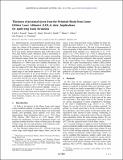| dc.contributor.author | Fassett, Caleb I. | |
| dc.contributor.author | Head, James W. | |
| dc.contributor.author | Smith, David Edmund | |
| dc.contributor.author | Zuber, Maria | |
| dc.contributor.author | Neumann, Gregory A. | |
| dc.date.accessioned | 2014-03-20T16:14:18Z | |
| dc.date.available | 2014-03-20T16:14:18Z | |
| dc.date.issued | 2011-09 | |
| dc.date.submitted | 2011-07 | |
| dc.identifier.issn | 00948276 | |
| dc.identifier.uri | http://hdl.handle.net/1721.1/85848 | |
| dc.description.abstract | Quantifying the ejecta distribution around large lunar basins is important to understanding the origin of basin rings, the volume of the transient cavity, the depth of sampling, and the nature of the basin formation processes. We have used newly obtained altimetry data of the Moon from the Lunar Orbiter Laser Altimeter (LOLA) instrument to estimate the thickness of ejecta in the region surrounding the Orientale impact basin, the youngest and best preserved large basin on the Moon. Our measurements yield ejecta thicknesses of ∼2900 m near the Cordillera Mountains, the topographic rim of Orientale, decaying to ∼1 km in thickness at a range of 215 km. These measurements imply a volume of ejecta in the region from the Cordillera ring to a radial range of one basin diameter of ∼2.9 × 106 km3 and permit the derivation of an ejecta-thickness decay model, which can be compared with estimates for the volume of excavation and the size of the transient cavity. These data are consistent with the Outer Rook Mountains as the approximate location of the transient cavity's rim crest and suggest a volume of ∼4.8 × 106 km3 for the total amount of basin ejecta exterior to this location. | en_US |
| dc.language.iso | en_US | |
| dc.publisher | American Geophysical Union | en_US |
| dc.relation.isversionof | http://dx.doi.org/10.1029/2011gl048502 | en_US |
| dc.rights | Article is made available in accordance with the publisher's policy and may be subject to US copyright law. Please refer to the publisher's site for terms of use. | en_US |
| dc.source | MIT web domain | en_US |
| dc.title | Thickness of proximal ejecta from the Orientale Basin from Lunar Orbiter Laser Altimeter (LOLA) data: Implications for multi-ring basin formation | en_US |
| dc.type | Article | en_US |
| dc.identifier.citation | Fassett, Caleb I., James W. Head, David E. Smith, Maria T. Zuber, and Gregory A. Neumann. “Thickness of Proximal Ejecta from the Orientale Basin from Lunar Orbiter Laser Altimeter (LOLA) Data: Implications for Multi-Ring Basin Formation.” Geophys. Res. Lett. 38, no. 17 (September 2011): , L17201, p.1-5. | en_US |
| dc.contributor.department | Massachusetts Institute of Technology. Department of Earth, Atmospheric, and Planetary Sciences | en_US |
| dc.contributor.mitauthor | Smith, David Edmund | en_US |
| dc.contributor.mitauthor | Zuber, Maria | en_US |
| dc.relation.journal | Geophysical Research Letters | en_US |
| dc.eprint.version | Final published version | en_US |
| dc.type.uri | http://purl.org/eprint/type/JournalArticle | en_US |
| eprint.status | http://purl.org/eprint/status/PeerReviewed | en_US |
| dspace.orderedauthors | Fassett, Caleb I.; Head, James W.; Smith, David E.; Zuber, Maria T.; Neumann, Gregory A. | en_US |
| dc.identifier.orcid | https://orcid.org/0000-0003-2652-8017 | |
| mit.license | PUBLISHER_POLICY | en_US |
| mit.metadata.status | Complete | |
